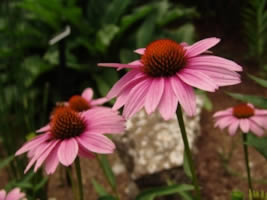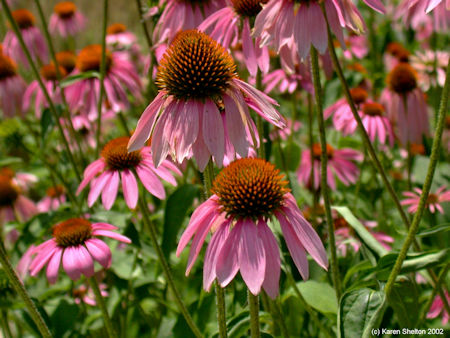Echinacea Herb, Purple Coneflower
Echinacea purpurea, Echinacea augustifolia

Other Names: Purple coneflower, Black Sampson, Coneflower, Eastern Purple Coneflower, Indian head, Kansas Snakeroot, Missouri Snakeroot, Rudbeckia, Scurvy root
Echinacea Photo by Karen Bergeron Copyright 2006
Echinacea Herb Use
Echinacea, or Coneflower, has been used for years in alternative medicine to support the immune system, and to purify the blood, especially during the cold and flu season. Extracts of Echinacea were found to enhance the cellular immune function of normal individuals and patients with AIDS and chronic fatigue syndrome. Unlike antibiotics, which directly kills bacteria, Echinacea makes our own immune cells more efficient in attacking bacteria, viruses and abnormal cells, including cancer cells. Echinacea is considered to be a most effective detoxicant for the urinary tract, circulatory, lymphatic, and respiratory systems. The roots and the whole plant are considered particularly beneficial in the external treatment of psoriasis, eczema and inflammatory skin conditions, sores, wounds, burns, and sore throat, possessing cortisone-like and antibacterial activity as well as showing skin regenerating properties.
The root is now confirmed by modern science as adaptogen, alterative, anti-inflammatory, antibiotic, antiseptic, aphrodisiac, depurative, diaphoretic, digestive, sialagogue.Scientific studies of Echinacea have confirmed the presents of natural chemicals, echinacosides, which increase white blood cell activity. Other valuable constituents include betaine, echinolone, inulin, humulene, polysaccharides, two phytosterols and fatty acids, oleic, cerotic, linolic and palmatic. Echinacea also contains chemicals that are highly insecticidal particularly to mosquitoes and house flies.
Echinacea Habitat and Description
Echinacea is a perennial native to North America from Virginia to Ohio and Michigan, south to Georgia and Louisiana. Its showy flowers can be found in summer, decorating open fields, dry open woods, prairies and barrens. Echinacea flowers bloom from July to October. Also known as Purple Coneflower, it is a very ornamental plant, and is often grown in gardens, parks and landscapes. It attracts butterflies to the garden, but watch out for slugs as they seem to love Echinacea.
Echinacea has daisy-like flowers with large rich purple or pink rays surrounding a high brownish-orange cone. The flower heads can reach 4 to 5 inches in diameter. Purple Coneflower stems are long 2 to 3 feet high, slender but stout, rough and bristly. The leaves are also bristly, dark green, lanceolate, alternate, and long petioled at the base, more sessile near the top of the stem. The roots are tapering, cylindrical, slightly spiral, and fibrous with as aromatic smell.
How to Grow Echinacea
Echinacea purpurea, or the Purple Coneflower is easy to grow from seed. Sow outdoors in very early spring or fall. Echinacea prefers light, loamy, well-drained soil and a sunny position, tolerates shade. Gather root and entire plant in fall or when in bloom, dry for later herb use.
Echinacea Folklore and History
Once used as an antidote to treat snakebites and other venomous bites by Native Americans. Believed in old English herbals to cure syphilis and rabies.
Echinacea Herb Tea Recipe
Infusion: To 1 tbsp. dry herb add 1 cup boiling water, steep 20 min., drink in mouthful doses throughout the day, at the beginning of a cold or for general fatigue.

Article by Deb Jackson & Karen Bergeron



